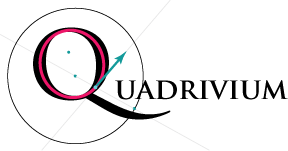Construction of the Quadrivium logo

Focus and directrix construction of an ellipse
An ellipse is the set of points the same distance from a point C and a circle. One of the main claims to fame of Newton's calculus was a derivation of the motion of planets around the sun. Their orbits are elliptical, with the sun at one focus. The speed is not constant. The same results can be derived without calculus, as this diagram shows. Here, the direction and size of the velocity are shown by the green vector. Its length is the same as CI. About the diagram:
|
| Mathematical Intentions |
Measuring the World |
Contact us |
Last updated December 12, 2009
Copyright 2009-10 David Dennis and Susan Addington. All rights reserved.